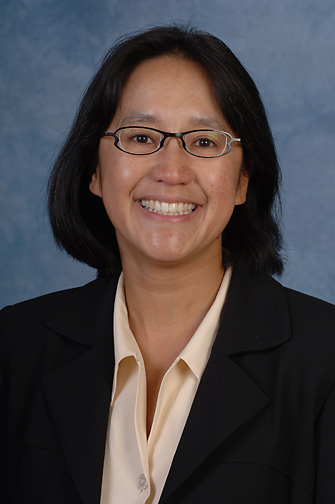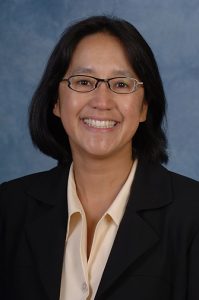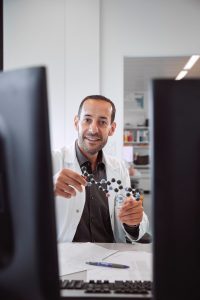SMA Foundation’s ‘Little Toolbox’ Helped Pave Way to Therapies
Written by |

Karen Chen, CEO of the SMA Foundation. (Photo courtesy of the Foundation)
[Editor’s Note: This is part of a series of articles into the discovery and development of Evrysdi, SMA’s newly approved disease-modifying therapy and its first oral and at-home one, as well as the scope of SMA issues and treatments. Here, we talk with the chief of the SMA Foundation about crucial early work that moved a rare disease into drug development.]
Beginning in the early 2000s, the SMA Foundation did essential groundwork that helped spark pharmaceutical interest in a rare disease like spinal muscular atrophy (SMA), from the tools needed to run trials of potential treatments to access to investigators able to lead them.
“We wanted to give them a kind of little toolbox they could use. I think that made it easier for companies to get into SMA,” Karen Chen, PhD, the foundation’s CEO, said in an interview with SMA News Today.
Chen, a neuroscientist by training, has worked in the field of neurodegenerative disorders since her postdoc at Genentech (now a subsidiary of Roche), where she stayed from 1992 to 1996.
Before joining the SMA Foundation in 2007, she led the development of therapies for such neurodegenerative diseases as Alzheimer’s and Parkinson’s at Elan Pharmaceuticals, moving to Roche in 2005.
Despite being a “dyed-in-the-wool” neuroscientist, she had never heard of SMA before the foundation came her way.
“I did have a lot to learn about rare diseases, about pediatric diseases, and a bit about muscle,” Chen said.
The SMA Foundation was established as a charitable research organization in 2003 by Loren Eng and Dinakar Singh, the parents of Ayra Singh, born in March 2000 and diagnosed with SMA in late 2001. Its guiding mission was, from day one, to accelerate the development of SMA therapies.
At the time, little interest was being shown to rare diseases and SMA was a mystery to much of the science world.
It was a “very hard sell,” Chen said.
The fortune in misfortune
Researchers in the mid-1990s, however, established the main genetic cause of SMA: the presence of mutations in the survival motor neuron 1 (SMN1) gene, preventing the production of SMN, a protein essential for muscle health.
They also discovered that the loss of SMN1-derived SMN can be partly compensated by the existence of a second survival motor neuron gene. SMN2 can produce 10%–15% of the normal SMN levels, and its number of gene copies determines SMA severity.
“There’s certainly the fortunate genetics of SMA. I don’t know of another disease where the missing gene has a duplicate,” Chen said.
That duplicate would serve as “a kind of natural clinical trial,” she added, allowing scientists to see that “increasing numbers of SMN2 led to milder cases of SMA — sort of a proof-of-concept natural trial that showed that targeting the SMN2 gene could have an impact on the disease.”
Indeed, it gave the foundation a good idea of where to begin looking for potential SMA therapies.
Getting pharma’s interest
To drum up interest, foundation leaders invited seven pharmaceutical and biotech companies to a dinner at a neurology conference in 2003. Three showed up: Genentech, Biogen, and Curis.
Both Biogen and Genentech ended up working on SMA treatments. Biogen partnered with Ionis Pharmaceuticals to develop Spinraza (nusinersen), which in December 2016 became the first approved disease-modifying treatment for SMA.
PTC Therapeutics, which the foundation approached in 2004 at a muscular dystrophy conference, began its own SMA program a year or so later.
“We met them there, they asked if we’d be interested in partnering with them — as indeed we did,” Stuart W. Peltz, CEO of PTC Therapeutics, said in a recent interview. “We didn’t know SMA all that well, but we thought it an important disease.”
A therapy PTC began investigating would become Evrysdi (risdiplam), the oral small molecule that resulted from years of collaborative work between Roche — which acquired an exclusive worldwide license to PTC’s program in 2011 — Genentech, PTC, and the foundation.
Evrysdi, like Spinraza, is now approved to treat all SMA types, among patients ages 2 months and older, in the U.S. It is under regulatory review in seven other countries, and the filing of an approval request to the European Medicines Agency, the regulatory body for the European Union, is expected soon.
Foundation scientists had known of PTC’s rare disease focus, and thought its RNA expertise and work on treatments for Duchenne muscular dystrophy, another rare neuromuscular disorder, would be an advantage. A collaboration officially began in June 2006.
Another PTC advantage was the presence of Sergey Paushkin, an MD with post-doctoral work in spinal muscular atrophy, who would go on to lead its SMA program. Paushkin left PTC in 2009 to join the foundation, serving as its director through 2017. He is now vice president and director of biology at Skyhawk Therapeutics.
The foundation also would give PTC a total of $13.1 million to support its SMA program work, Chen said.
Providing the essential ‘toolbox’
SMA Foundation help ranged from creating or promoting essential research tools — including animal models, cell lines, SMA natural history studies, biomarkers, protein assays, and clinical trial sites and endpoints — to offering patient perspectives.
Directly or indirectly, its groundwork was crucial for the preclinical and clinical development of Evrysdi, and helped with that of Spinraza and Zolgensma (by Novartis and AveXis), an approved gene therapy for SMA.
“All the tools we developed … we wanted to hand over to pharma,” Chen said, noting the foundation initiated a natural history study years before SMA treatments were even on the horizon. The foundation’s staff knew the importance of such a study in determining clinical measures and designing clinical trials.
“When you’re developing a [therapy] for a disease, you don’t know you’re moving into the clinic until probably a year before that happens,” she said. “And suddenly, everybody wants 10 years of natural history data, which, unless we have a time machine, it’s kind of impossible to generate.”
Natural history studies allow scientists and regulators to judge the value of different motor function measures for clinical trials. The development of one key measure, the Hammersmith Functional Motor Scale Expanded (HFMSE), was supported by the foundation. Hammersmith is now regularly used in studies of SMA patients.
Hasane Ratni, an expert scientist at Roche and leader of its Drug Discovery Chemistry program, specifically credited the efforts of both the SMA community and the SMA Foundation in keeping pharma researchers equipped, motivated, and focused.
Gains in “basic, translational and clinical research” came through the foundation’s support, Ratni said in an email exchange of questions.
“[W]ith all the new tools at our disposal and a strong confidence in how to treat the disease (increasing the SMN protein),” he added, “it is not a surprise that we have seen the advancements made in the SMA space in recent years, including the development of risdiplam.”
Most “beautiful,” though, was a first encounter with the people he was working to help treat.
“I am amazed by their stories; you cannot leave a meeting with them without feeling urgency about finding a way to make the potential treatment move forward and succeed,” Ratni said, relating a meeting the foundation made possible with a 15-year-old “who just wanted to keep the function that is working today.”
That “wanted” ability, said Ratni — who had expected the boy to talk about leaving his wheelchair — amounted to not losing control over a still-working hand. “All he wanted was to keep that one function,” the scientist said. “That really helped our team put things in perspective.”
Chen said the SMA Foundation has worked “from the get-go” to put an emphasis on the community it serves, bringing patients and their families forward. While its work in Zolgensma was mainly in helping with clinical trials, the foundation took a broader role in the efforts to advance Spinraza and Evrysdi.
Spinraza and Evrysdi both target the SMN2 gene, while Zolgensma works by introducing a functional SMN1 gene into cells.
The foundation chief emphasized that the organization served as “a clearinghouse or hub,” using its many connections with clinical sites, SMA specialists, and the U.S. Food and Drug Administration to assist companies working in SMA.
“I think the foundation’s strategy of making it low-hanging fruit,” Chen said, looking at the three targeted treatments now available, helped in “providing pharma with everything that they needed to move into the field.”








